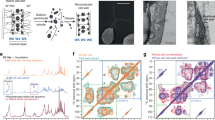Summary
The structure of a purified protein associated with the cell wall polysaccharides of the marine green algaeAcetabularia (Polyphysa) cliftonii has been studied by means of X-ray diffraction, infrared spectroscopy and circular dichroism. The homogeneous preparation of the cell wall protein has a molecular weight of 14,000, as determined by sodium-dodecylsulfate electrophoresis. Regular layer line reflections on the X-ray diffraction photographs suggest that a distinct order exists in the arrangement of the protein fibrils. Through infrared spectroscopy of thin aqueous films of the protein, as well as of the fibers, it was established that the α-helical structure is predominant in the cell wall protein. The fibers crystallize in a hexagonal unit cell witha=14.5 Å and c=27.0 Å, at a water content of two molecules per residue. Increase in water content causes an increase in thea-axis, but without change in thec-direction, thus keeping the α-helical conformation. Moreover the spectral data in the amide A, I, II, III, and IV-regions show that the cell wall protein has an ordered α-helical conformation.
Similar content being viewed by others
References
Beaven, G. H., andR. E. Holiday, 1952: Ultraviolet adsorption spectra of proteins and amino acids. Adv. Protein Chem.7, 319–386.
Björk, I., B. Å. Peterson, andK. Sjöquist, 1972: Some physicochemical properties of protein A fromStaphylacoccus aureus. Eur. J. Biochem.29, 579–584.
Dubois, M., K. A. Gilles, J. K. Hamilton, P. A. Rebers, andF. Smith, 1956: Colorimetric methods for determination of sugars and related substances. Anal. Chem.28, 350–356.
Elliot, A., 1953: The infra-red spectra of some optically active and meso-synthetic polypeptides. Proc. Roy. Soc. (London)A 221, 104–114.
—, andE. J. Ambrose, 1950: Structure of synthetic polypeptides. Nature165, 921–922.
Fish, W. W., K. G. Mann, andL. Tanford, 1969: The estimation of polypeptide chain molecular weights by gel filtration in 6 M guanidinium hydrochloride. J. biol. Chem.244, 4989–4994.
Formanek, H., S. Formanek, andH. Wavra, 1974: A threedimensional atomic model of the murein layer of bacteria. Eur. J. Biochem.46, 279–294.
Frei, E., andR. D. Preston, 1968: Non-cellulosic structural polysaccharides in algal cell walls. III. Mannan in siphoneous green algae. Proc. Roy. Soc.B 169, 127–145.
Göke, L., 1972: Zellwandpolypeptide: Verhalten bei der Morphogenese pflanzlicher Zellen und Mechanismus ihrer Bildung. Diplomarbeit, FB 23, Freie Universität Berlin.
—,H. H. Paradies, andG. Werz, 1974: Cell wall polypeptides ofPolyphysa (Acetabularia) cliftonii: Amino acid composition of stalk and cap cell wall polypeptides. Biochem. biophys. Res. Commun.60, 22–27.
Hämmerling, J., 1944: Zur Lebensweise, Fortpflanzung und Entwicklung verschiedener Dasycladaceen. Arch. Protistenkunde97, 7–56.
Huston, J. S., W. W. Fish, K. G. Mann, andC. Tanford, 1972: Studies on the subunit molecular weight of beef heart lactate dehydrogenase. Biochem.10, 3241–3249.
Krimm, S., 1962: Infrared spectra and chain conformation of proteins. J. molec. Biol.4, 528–540.
Lamport, D. T. A., 1967: Hydroxyproline-O-glycosidic linkage of the plant cell wall glycoprotein Extensin. Nature216, 1322–1324.
Lowry, D. H., N. A. Rosebrough, A. L. Farr, andR. J. Randall, 1951: Protein measurement with the folin phenol reagent. J. biol. Chem.193, 265–275.
Mitsui, J., 1973: Hydration-dependent α-β-transconformation of sodium poly-L-glutamate as abserved by X-ray diffraction. Biopolymers12, 1781–1786.
Miyazawa, T., andR. E. Blaut, 1961: The infrared spectra of polypeptides in various conformations: Amide I and II bands. J. Amer. Chem. Soc.83, 712–719.
Paradies, H. H., 1977: α-β-transition of protein S 4 fromE. coli ribosomes. Submitted to: Macromolecules.
—, andA. Franz, 1976: Geometry of protein S 4 fromE. coli ribosomes. Eur. J. Biochem.67, 23–30.
Pauling, L., andR. B. Corey, 1951: The structure of hair, muscle and related proteins. Proc. nat. Acad. Sci. (US.)37, 261–271.
Reynolds, J. A., andC. Tanford, 1970: The gross conformation of protein-sodium dodecyl sulfate complexes. J. biol. Chem.245, 5161–5165.
Schleifer, K. H., andO. Kandler, 1972: Peptidoglycan types of bacterial cell walls and their taxonomic implications. Bacteriol. Rev.36, 407–477.
Shapiro, A. L., E. Vinuela, andJ. V. Maizel, 1967: Molecular weight estimation of polypeptide chains by electrophoresis in SDS-polyacrylamide gels. Biochem. biophys. Res. Commun.28, 815–820.
Shumeli, Z., andW. Traub, 1965: Hydration-dependent α-β-transition of poly-lysine. J. molec. Biol.12, 205–214.
Susi, H., S. N. Timasheff, andL. Stevens, 1967: Infrared spectra and protein conformations in aqueous solutions. I. The amide I band in H2O and D2O solutions. J. biol. Chem.242, 5460–5466.
Suwalsky, M., andW. Traub, 1972: An X-ray diffraction study of poly-L-arginine hydrochloride. Biopolymers11, 623–632.
Tanford, L., K. Kawahara, andS. Lapange, 1967: Proteins as random coils. I. Intrinsic viscosities and sedimentation coefficients in concentrated guanidinium chloride. J. Amer. Chem. Soc.89, 729–736.
Weidel, W., andH. Pelzer, 1964: Bagshaped macromolecules—a new outlook on bacterial cell walls. Adv. Enzymol.26, 193–232.
Werz, G., 1970 a: Cytoplasmic control of cell wall formation inAcetabularia. Current Topics in Microbiol.51, 27–62.
—, 1970 b: Mechanisms in cell wall formation inAcetabularia. In: Biology ofAcetabularia, pp. 125–144 (Brachet, J., andS. Bonotto, eds.). New York: Academic Press Inc.
—, 1974: Fine-structural aspects of morphogenesis inAcetabularia. Int. Rev. Cytol.38, 319–367.
Zerban, H., M. Wehner, andG. Werz, 1973: Über die Feinstruktur des Zellkerns vonAcetabularia nach Gefrierätzung. Planta (Berl.)114, 239–250.
Author information
Authors and Affiliations
Rights and permissions
About this article
Cite this article
Paradies, H.H., Göke, L. & Werz, G. On the spatial structure of a plant cell wall protein. Secondary structure of a cell wall protein fromAcetabularia . Protoplasma 93, 249–265 (1977). https://doi.org/10.1007/BF01275657
Received:
Issue Date:
DOI: https://doi.org/10.1007/BF01275657




